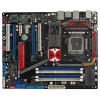- Qualcomm Launches Snapdragon 4 Gen 2 Mobile Platform
- AMD Launches Ryzen PRO 7000 Series Mobile & Desktop Platform
- Intel Launches Sleek Single-Slot Arc Pro A60 Workstation Graphics Card
- NVIDIA Announces Latest Ada Lovelace Additions: GeForce RTX 4060 Ti & RTX 4060
- Maxon Redshift With AMD Radeon GPU Rendering Support Now Available
ASUS Rampage Extreme

When the time came to design the Rampage Extreme, ASUS’ R&D went right to town. The X48-based board proves to be the most feature-packed one we’ve ever come across, and also one of the most overclockable. Aside from the robust design, water-cooled Northbridge and LCD Poster, the board even includes overclocking controls right on the PCB.
Page 3 – Checking Out the BIOS
ASUS has well-established themselves as being fully capable of delivering a motherboard that can appease even the most hardcore overclocker. To become what we consider an “overclocking” motherboard, three factors have to be met. First, the board needs to allow reasonable voltage tweaking, without any sane hard limits. The board also needs to deliver a wide-variety of tweaking options… options that even 99% of overclockers can’t fully understand.
Lastly, the board has to actually be able to overclock, and reach levels that are out of the ordinary for boards with equivalent chipsets. Well not surprisingly, the Rampage Extreme delivers on all accounts. When I first received the board, I was told to expect some very hardcore tweaking-ability and also that I should expect to hit well over 500MHz FSB with a Dual-Core. As you’ll see later, 500MHz FSB will be considered low.
The first piece of proof of ASUS’ serious attention to overclocking comes with the fact that the very first tab after opening the BIOS is the overclocking one. In total, you need to hit Page Down four times to soar through all of what’s available. The fact is, this board is for the hardcore overclockers, and the skies really the limit. You don’t need to be a hardcore overclocker to enjoy what’s here though, as most of the common options are available nearer the top, with all of the voltages found at the bottom.
Moving along to the next few tabs, you can see many familiar options. Nothing at all should be surprising to anyone, so I’ll let the next batch of photos speak for themselves.
Another area where ASUS’ enthusiasts’ boards stand-out is with regards to the monitoring. On most consumer-level boards, accessing either the voltage or thermal monitors would be a slow process – it can take about two seconds to actually read all of the information and in turn display it to you. The RoG boards offer nothing of the sort, though. Accessing each sub-section is an instant proposition, which is appreciated especially if you think your PC is overheating.
The sheer amount of information found in each is also rather impressive.
Below are the main boot options, none of which are any different than any other motherboard. This is one of the very few boards that actually disables the boot splash screen by default, however.
The last tab is for all your BIOS-flashing and profile-loading needs. Unlike many other ASUS enthusiast boards, this one features a backup BIOS that can be flashed to at any time. It’s a good idea to do it once you set the board up for the first time. That way, if something does happen to go horribly wrong, the board will be able to restore to the good BIOS without issue. This is a feature found on many Gigabyte boards, and I can attest to their usefulness.
The OC profile section isn’t the best I’ve seen, but it works. You can of course save a profile with all of the current settings and restore whenever you like. The problem is that saving and loading is awkward. The BIOS doesn’t tell you that you can’t use spaces in the names, and the general process isn’t as simple as it was before. Certainly not a deal-breaker though.
Before we get into our testing results, please read through our testing methodology page next, especially if you are new to the site, as valuable information regarding to how we conduct our testing is exposed in full detail. If you are already familiar with our methodologies, you can jump straight to page five.
Support our efforts! With ad revenue at an all-time low for written websites, we're relying more than ever on reader support to help us continue putting so much effort into this type of content. You can support us by becoming a Patron, or by using our Amazon shopping affiliate links listed through our articles. Thanks for your support!
























